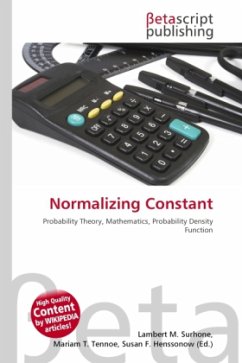
Normalizing Constant
Versandkostenfrei!
Versandfertig in 6-10 Tagen
26,99 €
inkl. MwSt.

PAYBACK Punkte
13 °P sammeln!
High Quality Content by WIKIPEDIA articles! High Quality Content by WIKIPEDIA articles! Bayes' theorem says that the posterior probability measure is proportional to the product of the prior probability measure and the likelihood function. Proportional to implies that one must multiply or divide by a normalizing constant to assign measure 1 to the whole space, i.e., to get a probability measure. In a simple discrete case we have where P(H0) is the prior probability that the hypothesis is true; P(D H0) is the conditional probability of the data given that the hypothesis is true, but given that ...
High Quality Content by WIKIPEDIA articles! High Quality Content by WIKIPEDIA articles! Bayes' theorem says that the posterior probability measure is proportional to the product of the prior probability measure and the likelihood function. Proportional to implies that one must multiply or divide by a normalizing constant to assign measure 1 to the whole space, i.e., to get a probability measure. In a simple discrete case we have where P(H0) is the prior probability that the hypothesis is true; P(D H0) is the conditional probability of the data given that the hypothesis is true, but given that the data are known it is the likelihood of the hypothesis (or its parameters) given the data; P(H0 D) is the posterior probability that the hypothesis is true given the data. P(D) should be the probability of producing the data, but on its own is difficult to calculate, so an alternative way to describe this relationship is as one of proportionality.












